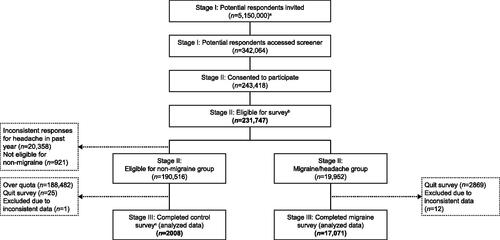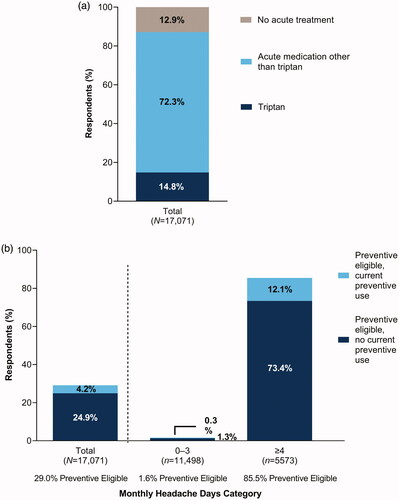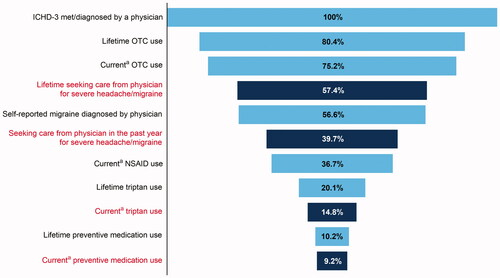Figures & data
Figure 1. Patient flow chart. aTargeted sampling to represent the Japanese adult population in terms of key demographic characteristics (age, sex, and geography) were applied. bThe diagnostic stage involved those who passed the screener stage and represented the Japanese census adult population. cA quota of 2000 was set for the non-migraine group, thus the majority of respondents who were eligible for the non-migraine group were over quota. Note. Eligible respondents who quit the survey or had inconsistent data were not included in the final analyses.

Table 1. Demographic characteristics of survey respondents.
Table 2. Diagnosis of migraine in survey respondents.
Table 3. Clinical features of migraine and patient-reported outcomes in the survey respondents.
Figure 2. HCP consultation patterns for the migraine group (N = 17,071). (a) Proportion of the migraine group who sought care for migraine/severe headache during their lifetime, and the four most common HCP types consulted. (b) Proportion of the migraine group who sought care for migraine/severe headache during the past 12 months, and the four most common HCP types consulted. Note. Pain specialist, emergency room, pharmacist, obstetrician/gynecologist, and occupational physician categories are not shown in this figure because of low consultation rates (≤3.3%) for lifetime care in the migraine group. Abbreviation. HCP, healthcare professional.

Table 4. Consultation and medication use in the migraine survey respondents.
Figure 3. Current medication use among Japanese people with migraine (N = 17,071). (a) Acute medications. (b) Preventive medication use among those eligible for preventive treatment. Preventive eligibility considered monthly headache days and MIDAS disability grade based on the American Headache Society consensus statementCitation22. Eligibility was defined three ways: ≥ 6 monthly headache days, 4–5 monthly headache days with at least some disability (MIDAS ≥ 6), or 3 monthly headache days with severe disability (MIDAS ≥ 21). “Current” defined as “currently using or typically keep on hand” for acute medications and “taken or used in the last 3 months” for preventive medications. Abbreviation. MIDAS, Migraine Disability Assessment.

Figure 4. Current situation of migraine treatment in Japan (N = 17,071). a“Current” defined as “currently using or typically keep on hand” for acute medications and “taken or used in the last 3 months” for preventive medications. Abbreviations. ICHD-3, International Classification of Headache Disorders, 3rd edition; NSAID, nonsteroidal anti-inflammatory drug; OTC, over-the-counter.

